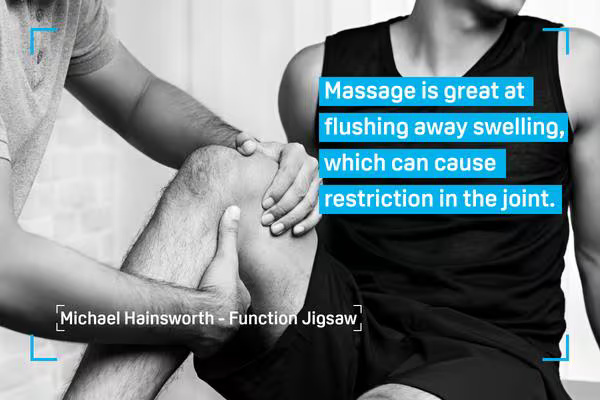If you’re living with arthritis you’ll be all too familiar with joint pain and the frustration that comes with stiffness and restricted movement.
As Michael Hainsworth, therapist at sports injury specialists Function Jigsaw explains, how massage can be a stepping stone on the way to getting and staying active again.
The Basics
Massage is great for relieving muscle aches and joint pain. It usually involves applying moderate pressure using the hands. I focus on treating patients with two types of arthritis, but predominantly those with osteoarthritis.
Osteoarthritis, osteo meaning bones, refers to the grinding down of the cartilage at the end of the bone – this cartilage is what allows our bones to move smoothly. When worn down this leads to joint aches and stiffness, particularly in the morning, and can in the worst cases render people immobile. In simple terms, when muscles tense up, the gap between joints gets smaller, causing, in bad cases, bone to grind against bone. With massage, we work to enlarge the joint space and lengthen muscles to provide pain relief.
For example, to improve an arthritic knee you can release the tension in the calf muscles, hamstrings and quads to create a little space in the joint.
Move to the max
One of the key aspects of massage is an increase in the range of motion, this helps reduce pain and also increases the joint space to avoid that bone on bone grind.
Massage increases blood flow to the focus area, which promotes a healing response as fresh blood carries fresh nutrients, and helps deliver synovial fluid to the area which lubricates the joints.
Massage is great at flushing away swelling, which can cause restriction in the joint. With a swollen joint you are unlikely to have full movement, massage can help this.
A better quality of life
While there’s no direct correlation between massage and increased strength, regular massage treatments could widen your range of motion, increase your pain threshold or decrease general pain. By relieving stress and anxiety you can also trigger a release of endorphins, the happy hormones your body produces when you exercise. All of these benefits add up to a better quality of life.
If you’re heading towards retirement, that can help you return to doing activities that arthritis has started to restrict. By making it easier to be active you’ll prevent the muscle wastage that affects so many of the elderly when they’re immobile. Lack of activity due to arthritis can cause muscle wastage and weakness so staying mobile is important for staying healthy.
Tailored to your needs
If you’ve not tried massage as a treatment before there’s no need to be nervous, your therapist will be able to tailor the treatment to your needs and pain threshold after a quick consultation.
Moderate pressure is the most beneficial as it relieves the muscle tension. We’ve also noticed with our patients that it’s the best for pain reduction. Light pressure is often too light for the reduction of swelling but your therapist will start light and build to what is most beneficial.
Moderate pressure is shown to stimulate pressure receptors underneath the skin and the brain receives these signals and cuts off the pain fibres. There’s a lot of research studies on clients self-massaging, applying a little bit of pressure to around their joints and muscles to reduce pain.
Going solo
Self-massage is something everyone can do, although it depends on which part of the body your arthritis affects. Shoulders might be hard to work on, but knees are very accessible. The key to self-massage is to ease into it, making gentle motions to start, to promote the synovial fluids.
We also advise regular exercise which is great for the promotion of synovial fluids. Of course it’s a vicious cycle for people with arthritis. You get people saying they can’t exercise because they are stiff and it hurts when they exercise. But you must move to help ease arthritic pain.
While you may have to live with arthritis, managing the pain it causes is very possible and massage can play a part in that.



